But to understand where you rank in the first place, you’ll need a rank tracker.
In this guide, you’ll learn how to choose the right rank tracker for you, and how to use it to improve SEO.
But first, let’s make sure we’re on the same page.
- What is rank tracking?
- Why is rank tracking important?
- How to choose the best rank tracker
- How to use a rank tracker to improve SEO
Rank tracking is the process of checking search engine ranking positions for certain keywords over time. A rank tracker is the software or tool that automates this process for you.
Rank tracking helps you understand which keywords and pages need your attention most. But that’s not the only reason it’s important. It also gives you some insight into whether your SEO efforts are paying off.
For example, our visibility for all our tracked keywords is improving over time:

This tells us that our SEO efforts are having the desired effect on the whole. If visibility were declining overall, that might be something we’d want to investigate further to hone our SEO strategy.
Most rank trackers also give you various ways to slice and dice the data for even more actionable insights, which we’ll talk about shortly.
Why can’t you just check rankings yourself?
Rank trackers save time by automating the rank tracking process. But if you only have a few keywords to track, you might be wondering why not just type them into Google and check ranking positions manually?
The answer is that manual rank checking rarely gives an accurate view of reality because Google’s search results are heavily personalized based on things like your:
- Location
- Browsing history
- Language
- Device (desktop/mobile)
For example, these are the search results for “how to make flapjacks” in the UK:

If we use Ahrefs’ SEO Toolbar to simulate the exact same search from the US, the results are completely different:

This happens because the definition of flapjacks varies between nations. In the UK, it’s an oat bar. In the US and Canada, it’s a pancake.
What about going incognito?
Using an incognito browser tab solves the issue of personalization based on browsing history, but it doesn’t solve anything else. Your IP address remains visible, so Google will still personalize the search results based on your location and inferred language.
For example, here’s that “how to make flapjacks” search in an incognito tab:
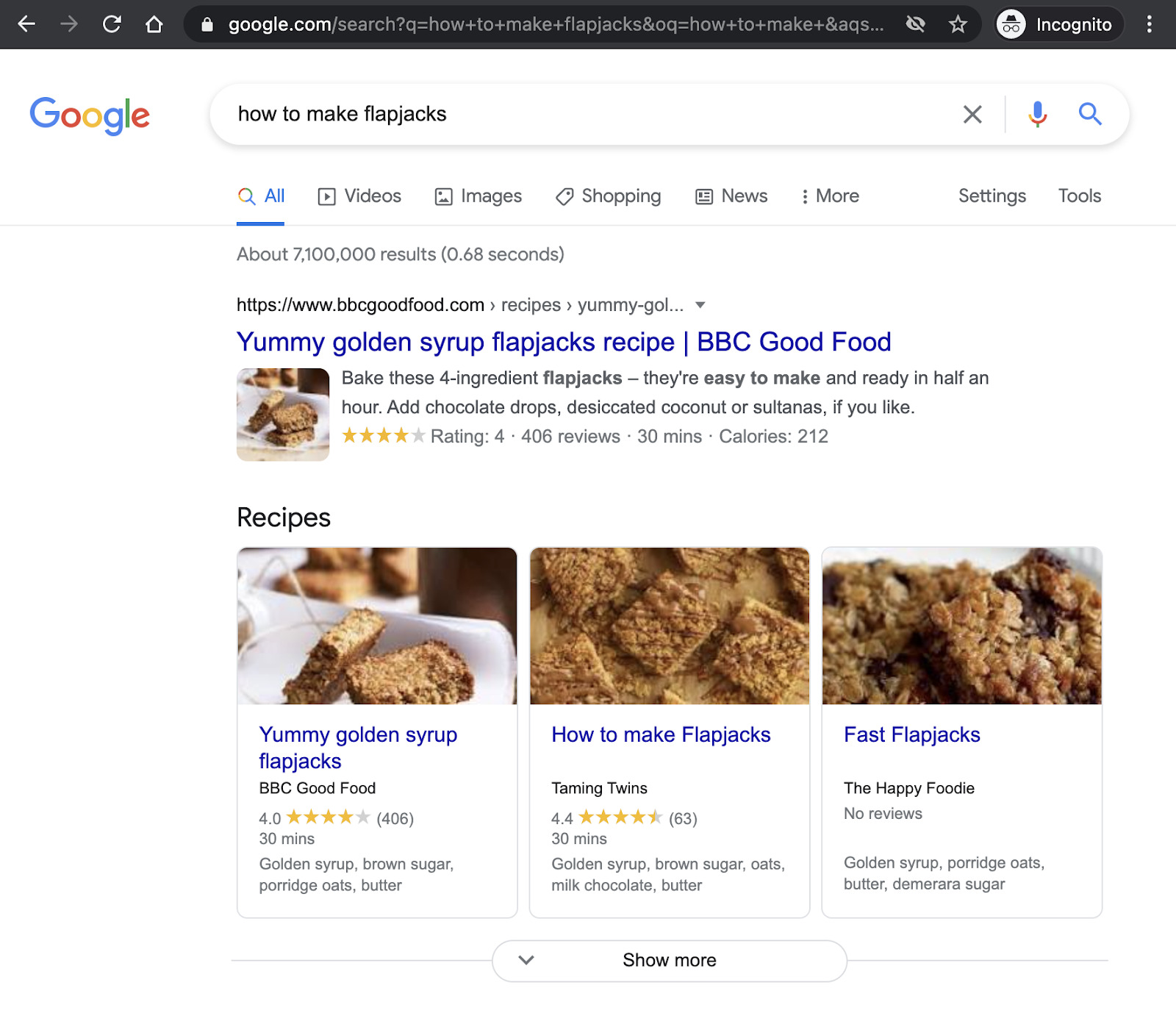
Google still shows recipes for British flapjacks because it knows my IP address.
Bottomline: even if you just want to check rankings for one or two keywords, you should use a rank checker. If you’re not ready to pay for one, try our free keyword rank checker.

Right now, you’re reading the Ahrefs Blog. Ahrefs is an SEO toolset with its own rank tracker. We think it’s one of the best on the market but we’re clearly biased, so I won’t insult your intelligence by creating a list of the ‘best’ rank trackers with Ahrefs at the top.
But what I will share are the results of a recent Facebook poll by Matt Diggity:
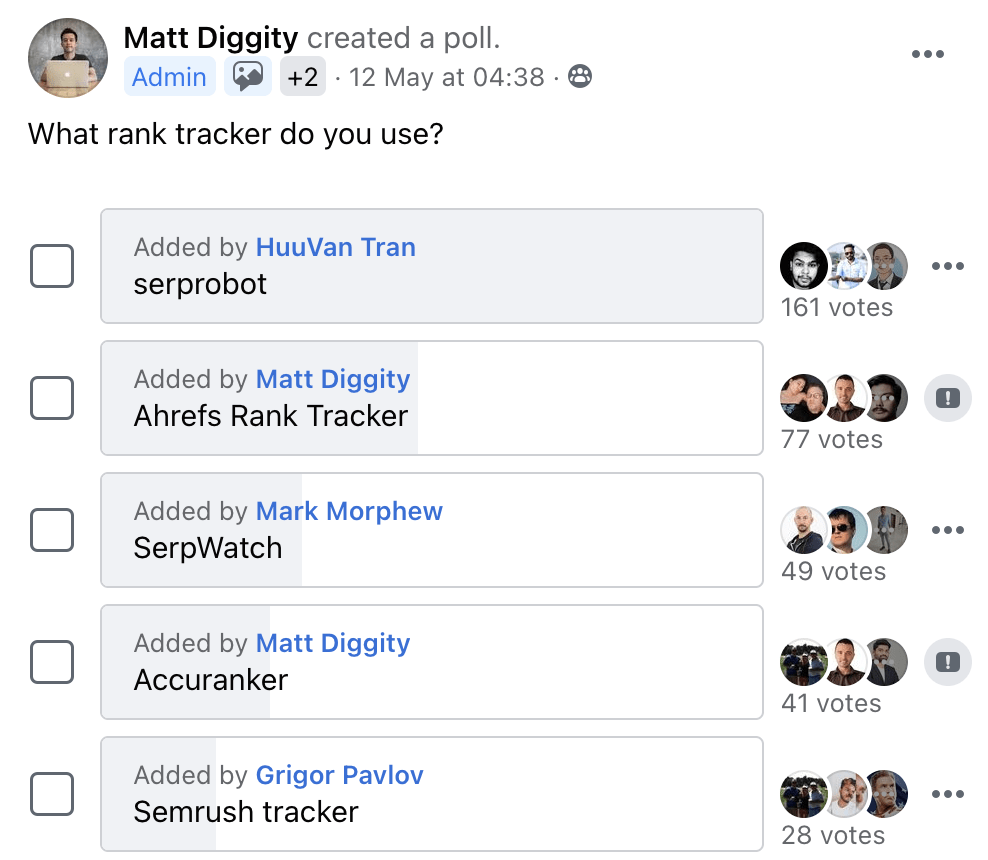
Interestingly, only two of the top five are standalone rank tracking tools. The others are included as part of an all-in-one SEO toolset like Ahrefs.
This leads me to an interesting point…
If you’re doing SEO in any serious capacity in 2021, you’ll need an all-in-one SEO tool like Ahrefs for crucial tasks like keyword research and link building. Given that most of these tools include a rank tracker, arguably the best rank tracker for most people is the one included with their favorite SEO toolset.
But, if you’re yet to invest in an all-in-one SEO toolset or would just prefer a standalone rank tracker, what features should you be looking for?
Here are a few features you might need:
Location support
Rankings vary from location to location. If your website or business primarily serves the US market, you’ll want to track rankings in the US. If it primarily serves the UK market, you’ll want to track UK rankings. If it primarily serves the Canadian market… you get the idea.
You might even want to track rankings across multiple countries if you’re working for a multinational corporation.
Naturally, Ahrefs’ Rank Tracker supports most countries; 187 and counting.
If you’re doing local SEO, you’ll want a rank tracker with more granularity so you can track rankings at the state, city or zip code level—as you can in Ahrefs’ Rank Tracker:
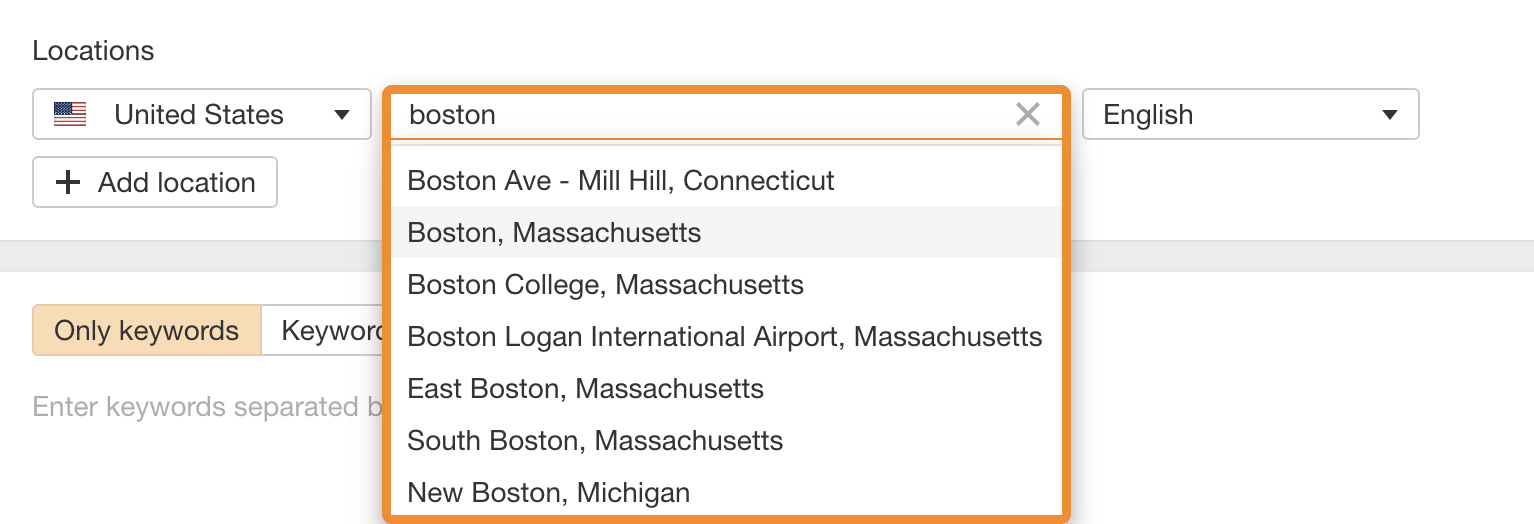
Language support
If your website targets a locale with more than one official/common language, you’ll probably want to track rankings in multiple languages within that locale.
For example, say you run a restaurant in Barcelona. This city is in Catalonia where, according to Wikipedia, there’s a pretty even mix of Spanish and Catalan speakers. If your restaurant’s website is available in both languages, as is the case for this one, you’ll probably want to track rankings for both Spanish and Catalan searchers.
Here’s how you’d do that in Ahrefs’ Rank Tracker:

Device support (desktop/mobile)
Desktop and mobile ranking signals aren’t identical, so it’s not uncommon for rankings to vary between desktop and mobile.
For example, desktop users typically have faster internet connections than mobile users, so it might be a more important ranking factor on mobile than desktop. In other words, if you have a slow site, it might negatively impact mobile rankings more than desktop rankings.
Here are a couple of other things that may cause ranking discrepancies across devices:
- Poor mobile friendliness
- More intrusive ads/interstitials on one device over the other
If you’re using Ahrefs’ Rank Tracker, you can easily toggle between mobile and desktop rankings and check average positions across devices.
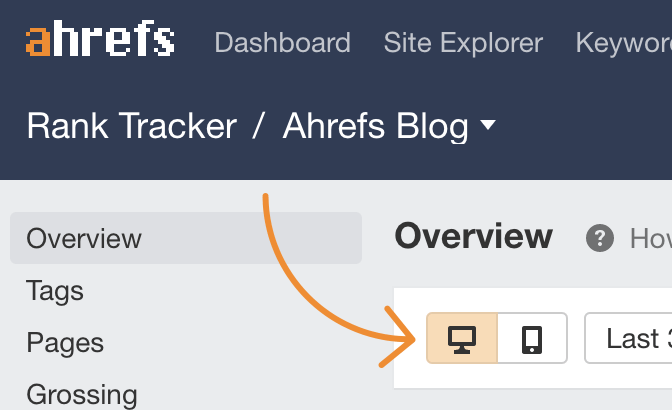
SERP feature tracking
SERP features are non-traditional search results like featured snippets and top stories carousels. Ranking in some of them can help drive more traffic to your website, so it makes sense that you’d want to track their prominence for important keywords over time.
Many rank trackers give you this ability including Ahrefs’ Rank Tracker, which automatically tracks the prominence and ownership of most SERP features for tracked keywords.
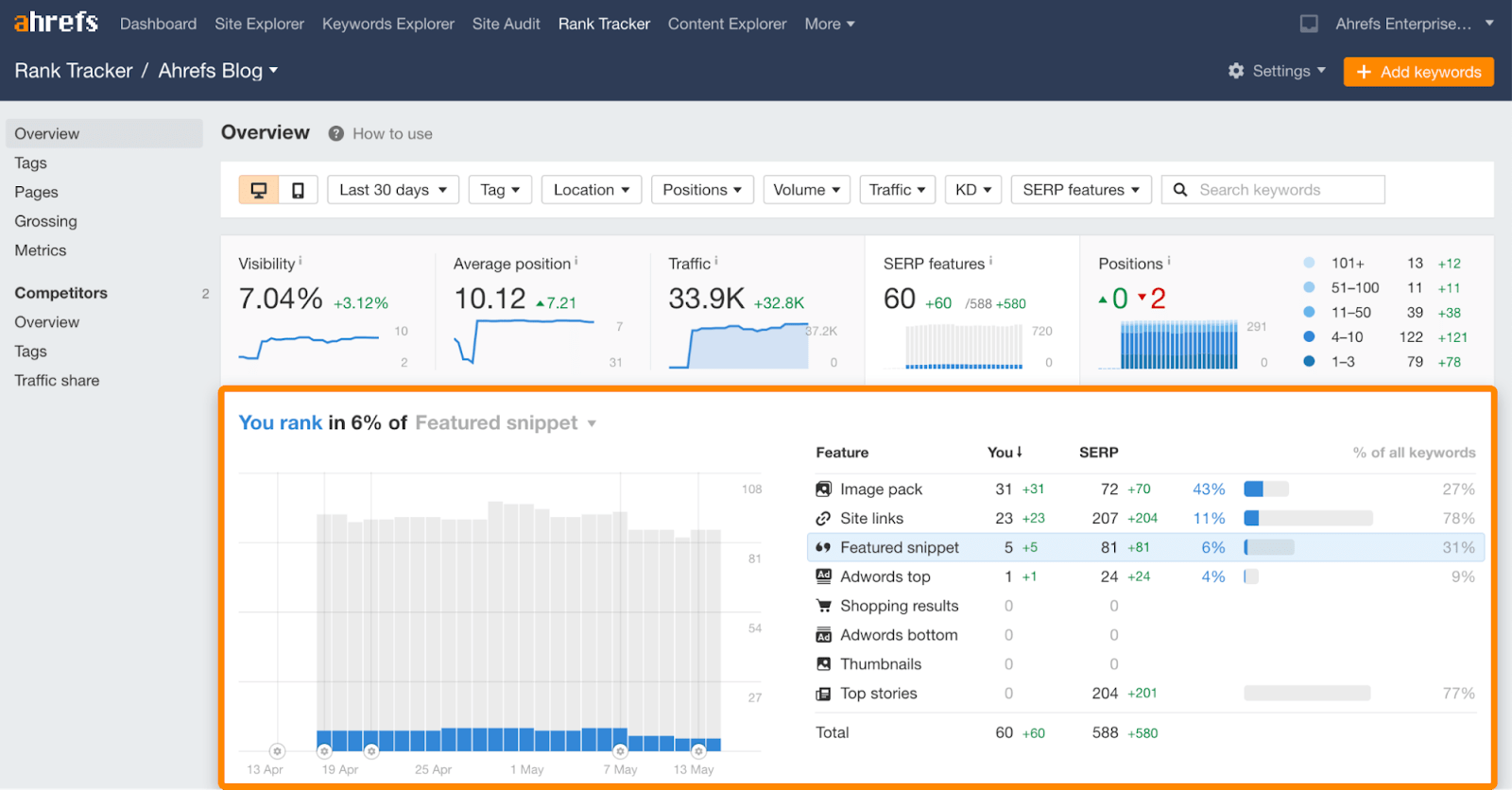
Daily ranking updates
Frequency of ranking updates important for identifying potential issues quickly as they arise. In Ahrefs’ Rank Tracker, update frequency depends on your plan. It’s anywhere between one* and seven days.
It’s easy to spend your days obsessing over every little fluctuation in a rank tracking tool, but this isn’t a productive use of your time. Instead, you should use a rank tracker to identify ways to improve SEO and get more organic traffic.
Let’s look at a few ways to do that:
- Find the best featured snippet opportunities
- Track organic search share of voice by topic
- Find low-hanging opportunities to beat competitors
- Find pages that are ready for a refresh
- Find competitors to kickstart your keyword research
Find the best featured snippet opportunities
Featured snippets are short answers that often appear at the top of Google’s search results. They’re pulled from one of the top-ranking pages.
For example, Google pulls this snippet from our guide to hreflangs:
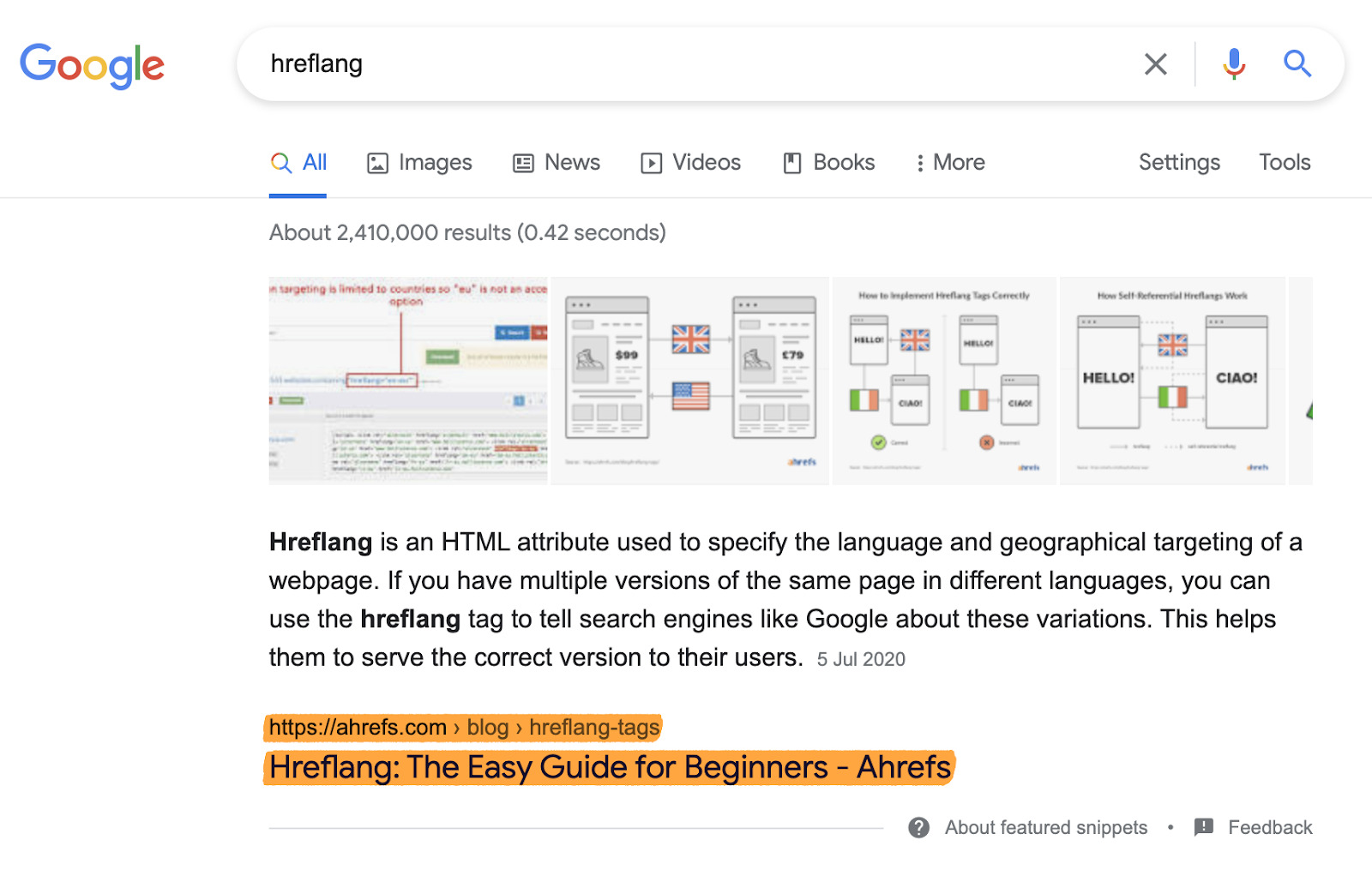
By winning featured snippets, you can often shortcut your way to the top of Google and boost organic traffic in the process.
How do you find featured snippet opportunities?
Look for keywords with featured snippets that you don’t currently own where you also rank in the top 10. You can often win these just by adding or editing the content on your page.
If you’re familiar with Ahrefs, you’ll know you can do this for any website in Site Explorer. Just head to the Organic Keywords 2.0 report, filter for featured snippets, and check the “where target doesn’t rank box” to see unowned snippets.

But there’s one big benefit to doing this in Rank Tracker: You can see the historic prevalence of the featured snippet over time.
This is useful because it’s likely not worth pursuing featured snippets if Google rarely shows them in the SERP.
For example, there’s currently a featured snippet showing for “find email address”:

Yet, if we click the caret and check the SERP feature history, we see that Google is only showing the featured snippet sporadically. It’s only been spotted in the SERP by Rank Tracker for a handful of days in the past month:

For “ecommerce SEO,” on the other hand, Google is consistently showing the featured snippet:

So, for us, it would make more sense to pursue the featured snippet for “ecommerce SEO” over “find email address” because its prevalence presents a greater traffic opportunity.
Track organic search share of voice by topic
Organic search share of voice tells you how much market share various websites own for a given set of keywords. In this case, your tracked keywords.
Before you can see this in Rank Tracker, you first need to specify one or more competitors.
If you haven’t done this already, head to the Competitors Overview tab, hit the option to add competitors, then enter the competitors’ domains or paths you want to track. If you’re not sure who your competitors are, check the suggestions based on keyword intersections and hit the “+” button to add them to your project.
For the Ahrefs Blog, we’ll add Backlinko and the Moz blog.

If we now head to the Competitors Overview report, we can see that we’re trumping Moz in terms of “visibility” for our tracked keywords, which is the percentage of all clicks for the tracked keywords that land on each website. And we’re roughly on par with Backlinko.
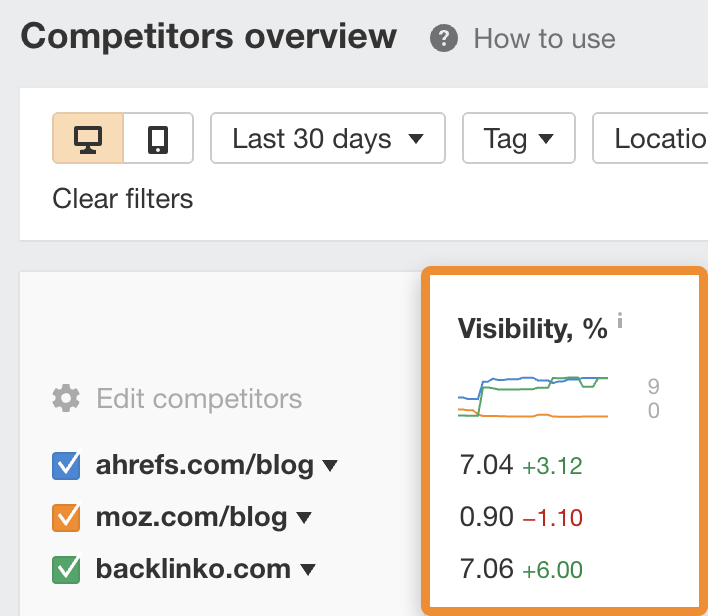
It’s a similar story for average ranking positions, traffic, and SERP features too:

But this gets even more powerful when you group keywords by topic using tags, because you can then track organic share of voice by topic using the Competitors Tags report.

Now we can see that although we’re way ahead of the competition when it comes to content about keyword research, Backlinko is beating us for content about link building.
If we check the Traffic tab, we see that this translates to traffic too:
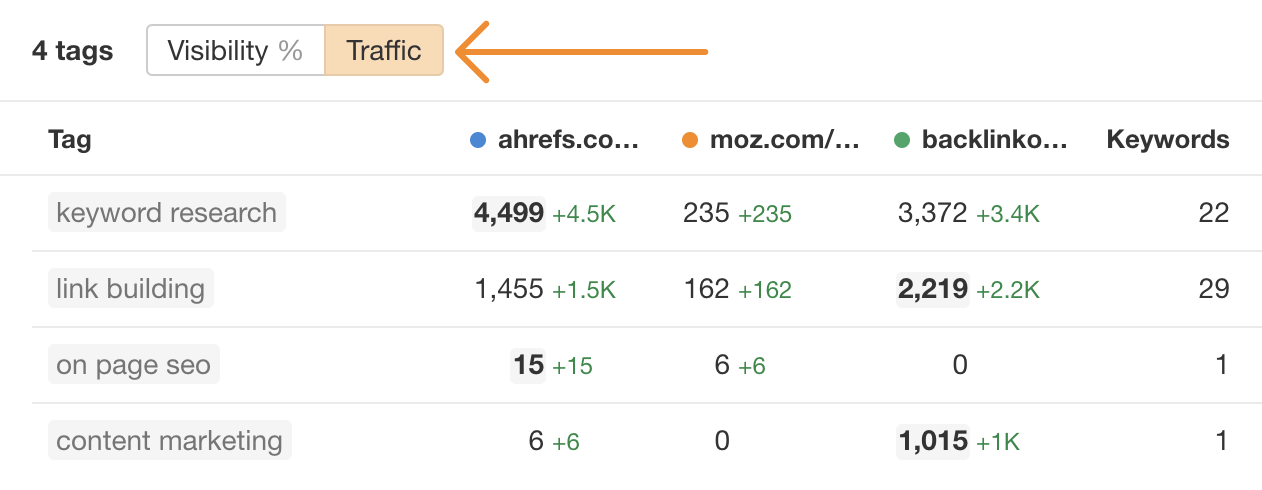
So we might want to investigate this further and see if there’s anything we can do about it. For instance, we might need more backlinks to compete, or we might be able to boost rankings for this topic by creating a content hub.
Find low-hanging opportunities to beat competitors
If competitors are outranking you for important keywords, you might want to prioritize ranking higher for them to win back traffic.
Here’s how to find these keywords:
- Go to your project in Rank Tracker
- Click the Competitors Overview report
- Filter for top 10 rankings
- Sort the table by competitor rankings from highest to lowest

For example, Backlinko is outranking us for keywords like “LSI keywords” and “blog post templates”:

Given that we’re only a few positions behind, it might be worth investigating the SERP to see if there’s anything we can do to rank higher.
In the case of “LSI keywords,” it looks like we need way more backlinks—which won’t be easy:

In the case of “blog post templates,” Backlinko is ranking one position above us in pole position despite having roughly the same number of linking websites.

Although there could be many reasons for that, one factor may be that Backlinko arguably has a more enticing angle in the title tag (“work like a charm” vs “when to use them”).
Find pages that are ready for a refresh
Rankings don’t last forever. Even if your page was once in pole position for your target keyword, chances are it will eventually drop in rankings and lose traffic.
It’s at this stage that you’ll want to refresh and republish the page.
To find pages that are potentially ripe for a refresh, go to the Grossing report in Rank Tracker and look for keywords with declining rankings over time.
For example, our ranking position for “local SEO” has dropped from #1 to #9 since we started tracking the keyword.

If we check that post in Site Explorer, we also see a corresponding drop in estimated US traffic:
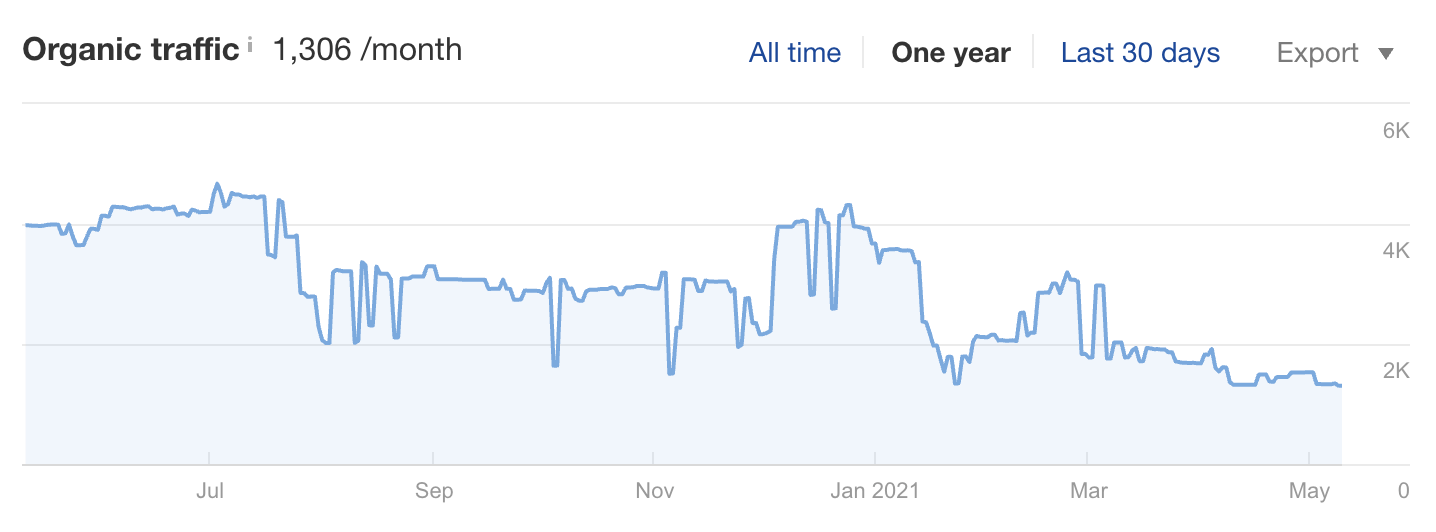
It’s quite likely that if we were to refresh this post for 2021, it would regain at least some level of rankings and traffic.
Learn how to do that in our full guide to refreshing and republishing content.
Find competitors to kickstart your keyword research
Looking for topics covered by online competitors is one of the best keyword research tactics. But it works best when analyzing the websites of close competitors.
To quickly find these competitors, head the Traffic share report in Rank Tracker and hit the “Domains” toggle:

Because Rank Tracker generates these competitors by looking for websites attracting search traffic from your tracked keywords, it often shows close organic search competitors that you may have overlooked.
For example, we see bigcommerce.com among our top competitors by traffic share:

Given that this website is neither a direct business competitor or an SEO blog, we would probably have overlooked it when doing keyword research. But if we plug the website into Site Explorer and check the Top Pages report, we see a few topics that might be worth us covering like “small business tips” and “marketing calendar.”
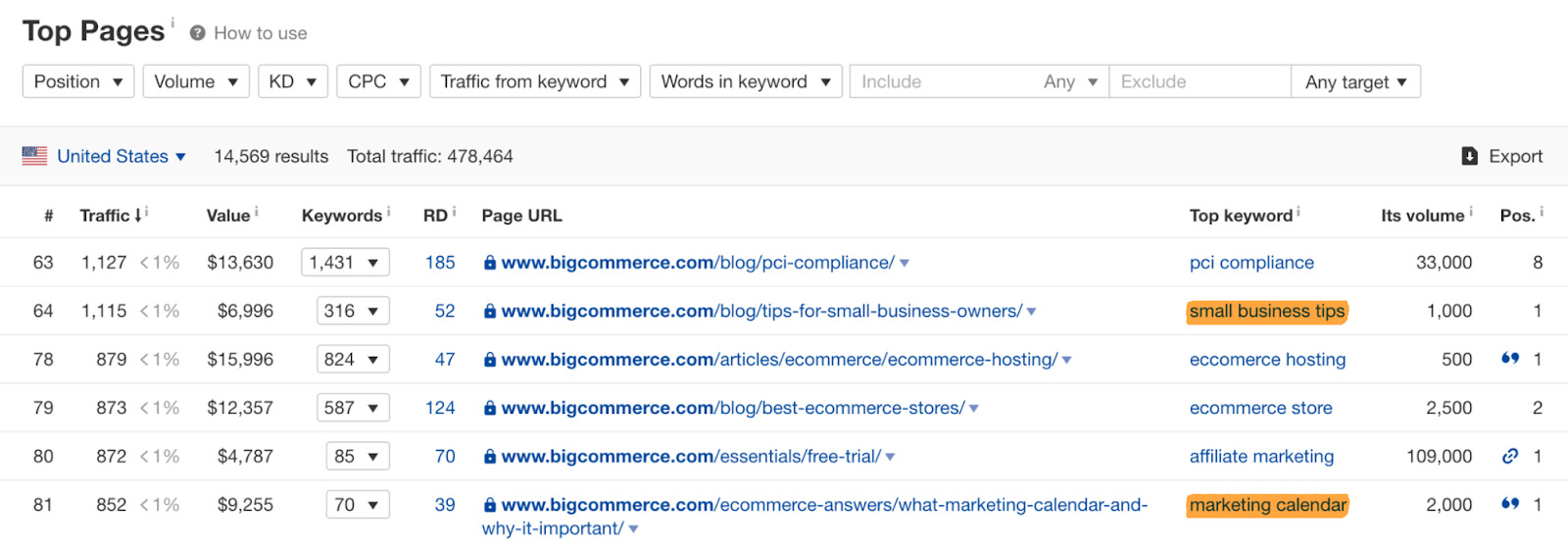
If you’ve tagged your keywords by topic in Rank Tracker, you can take this competitor discovery method even further using the tag filter.
For example, if we filter by our “link building” tag, we see a couple of competitors that didn’t show up before like outreach.io and linkbuilder.io.

Given that we’re always on the lookout for more link-building-related topics, it would probably also be worth checking the Top Pages report for these websites in Site Explorer.
In fact, if we do that with linkbuilder.io, we see a few good link-building-related topics that we haven’t covered yet like “link exchanges” and “link building expert.”

FAQs
Before we wrap things up, let’s answer a few common questions about rank trackers.
What is the best rank tracking tool?
The best rank tracking tool is subjective but according to one industry poll, SERPRobot, Ahrefs’ Rank Tracker, Accuranker, and SE Ranking are the most widely used.
Is there a free rank tracker?
Yes, many. We even have our own completely free keyword rank checker.
Can I track local rankings in a rank tracker?
It depends on the rank tracking tool. Some have that capability; some don’t. You can track rankings at the country, state, city, or zip code level in Ahrefs’ Rank Tracker.
Final thoughts
Rank tracking can quickly become a time suck. If you’re obsessing over every little ranking fluctuation on a daily basis, you’re using it wrong. The best rank tracker is one with features and functionalities that actually help you improve SEO and get more traffic.
Got questions? Ping me on Twitter.



